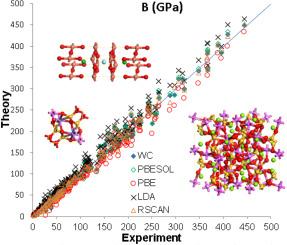Accuracy of calculated elastic properties of inorganic materials: Density functional theory and machine-learned potentials
IF 2.9
Q2 MATERIALS SCIENCE, MULTIDISCIPLINARY
引用次数: 0
Abstract
Elastic coefficients of a large set of inorganic compounds are calculated using the most popular expressions for the exchange–correlation functional in the density functional theory (DFT) formalism. We compiled an extensive database of experimental measurements for comparison with the calculated properties, and suggest that the meta-GGA RSCAN functional produces the most accurate description overall, followed by PBESOL or Wu-Cohen formulations. We show that the most commonly used functional, PBE, offers the least accurate representation of elastic properties. A popular machine-learning potential scheme, MACE, using MP-0b, OMAT-0, or MACE-MATPES-r2SCAN-0 models has an RMS error for bulk and shear modulus that is only 1.5–2 times worse than the best DFT result while being 3–4 orders of magnitude faster. We demonstrate that calculated elastic properties can be used in conjunction with empirical expressions for Vickers hardness and fracture toughness to produce reasonable estimates of these mechanical properties for engineering applications of covalent and ionic crystals.

无机材料弹性特性计算的准确性:密度泛函理论和机器学习势
利用密度泛函理论(DFT)中最流行的交换相关泛函表达式,计算了大量无机化合物的弹性系数。我们编制了一个广泛的实验测量数据库,将其与计算性质进行比较,并表明meta-GGA RSCAN函数总体上产生了最准确的描述,其次是PBESOL或Wu-Cohen公式。我们表明,最常用的函数,PBE,提供了最不准确的弹性性能表示。MACE是一种流行的机器学习方案,使用MP-0b、OMAT-0或MACE- matpes - r2scan -0模型,其体积和剪切模量的均方根误差仅比最佳DFT结果差1.5-2倍,而速度快3-4个数量级。我们证明,计算出的弹性性能可以与维氏硬度和断裂韧性的经验表达式结合使用,从而对共价和离子晶体的工程应用的这些力学性能产生合理的估计。
本文章由计算机程序翻译,如有差异,请以英文原文为准。
求助全文
约1分钟内获得全文
求助全文
来源期刊

Materialia
MATERIALS SCIENCE, MULTIDISCIPLINARY-
CiteScore
6.40
自引率
2.90%
发文量
345
审稿时长
36 days
期刊介绍:
Materialia is a multidisciplinary journal of materials science and engineering that publishes original peer-reviewed research articles. Articles in Materialia advance the understanding of the relationship between processing, structure, property, and function of materials.
Materialia publishes full-length research articles, review articles, and letters (short communications). In addition to receiving direct submissions, Materialia also accepts transfers from Acta Materialia, Inc. partner journals. Materialia offers authors the choice to publish on an open access model (with author fee), or on a subscription model (with no author fee).
 求助内容:
求助内容: 应助结果提醒方式:
应助结果提醒方式:


